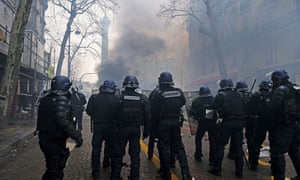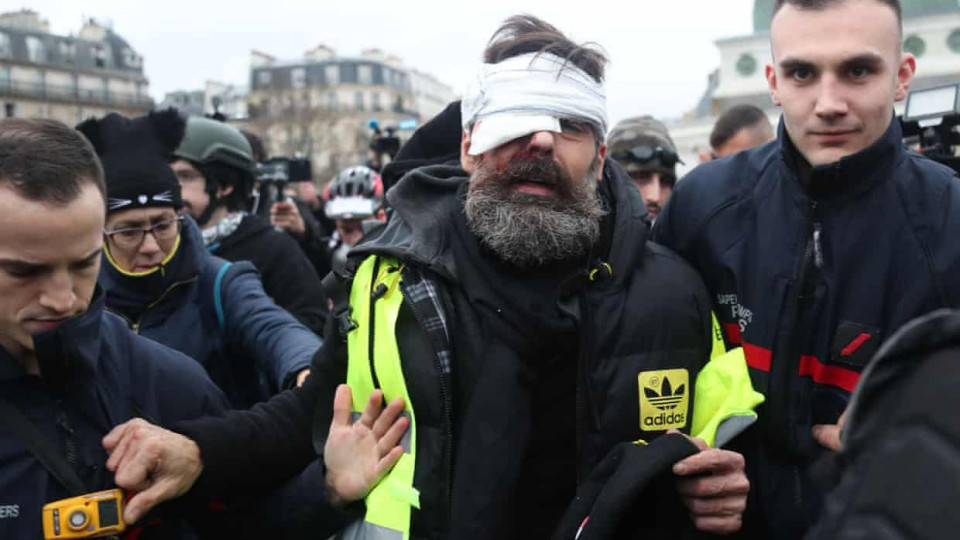
The French government is under growing pressure to review police use of explosive weapons against civilians after serious injuries were reported during gilets jaunes street demonstrations, including people alleged to have lost eyes and to have had their hands and feet mutilated.
France’s legal advisory body, the council of state, will on Wednesday examine an urgent request by the French Human Rights League and the CGT trade union to ban police from using a form of rubber-bullet launcher in which ball-shaped projectiles are shot out of specialised handheld launchers. France’s rights ombudsman has long warned they are dangerous and carry “disproportionate risk”.
Lawyers have also petitioned the government to ban so-called “sting-ball” grenades, which contain 25g of TNT high-explosive. France is the only European country where crowd-control police use such powerful grenades, which deliver an explosion of small rubber balls that creates a stinging effect as well as launching an additional load of teargas. The grenades create a deafening effect that has been likened to the sound of an aircraft taking off.
France’s centrist president, Emmanuel Macron, is facing renewed calls to ban such weapons after Jérôme Rodrigues, a high-profile member of the gilets jaunes (yellow vests) demonstrators was hit in the eye on Saturday in Paris. He is said by his lawyer to have been disabled for life.
Rights groups say Rodrigues’s case is the tip of the iceberg. Lawyers estimate that as many as 17 people have lost an eye because of the police’s use of such weapons since the start of the street demonstrations, while at least three have lost their hands and others have been left with their face or limbs mutilated. Injuries have happened at demonstrations in Paris and other cities, including Bordeaux and Nantes.
Aïnoha Pascual, a Paris lawyer representing several of the injured people, including one person who had part of his hand ripped off, and another left partially deaf and with facial injuries, said never in recent history had so many serious injuries been seen during protests. She said using the sting-ball grenades was akin to using military weapons against a civilian population. “These weapons are a very real problem. In the 1980s, if one person was hit in the eye at a demonstration there would be a huge reaction, yet now there is no reaction from government.”

Dominique, 54, a childcare worker from rural Normandy, described how she saw her sons seriously wounded. One of them had his hand ripped off by, she believes, a sting-ball grenade on the Champs Élysées in Paris in November during a family day out to support the gilets jaunes demonstrations.
She said: “It was very calm where we were standing. There were a few people, a child, nothing extraordinary and suddenly my sons were hit. I remember seeing my son’s mutilated hand, his face and body peppered with shrapnel as if a paintbrush had been flicked at him. His brother, injured too, had to carry him because he couldn’t walk. I will never be able to forget those images.”
She said her 21-year-old son’s right hand was blown off and her other son had injuries to his leg and feet. “I saw things that even in a film I wouldn’t have believed. It was like a war. It was our first demonstration. I had no idea the police had weapons that could do that damage.”
Both her sons have been operated on several times. “The physical damage was acute, but so is the psychological damage. Any noise makes me jump now, even the sound of a plastic bottle being crushed. I can’t look at images of police on TV. My son has holes in his forehead; he can’t look at his mutilated hand. My other son will have shrapnel in his body for life as it’s too dangerous to remove all of it. We feel totally alone. We haven’t heard from the state. It’s as if we don’t exist.”
The government has not commented on specific allegations or given any breakdown of injuries. The interior minister, Christophe Castaner, on Tuesday said only that 1,900 people had been injured in all circumstances since the start of the gilets jaunes demonstrations in November. Lawyers and journalists attempting to compile lists of police weapon injuries estimate at least 100 people have been wounded. A total of 101 investigations have been opened by France’s police watchdog.

Castaner said 1,200 police officers had been injured since the start of the gilets jaunes protests and officers were acting “proportionately” in their use of weapons. He said because France was dealing with a “crisis” situation, any review of policing would not happen at the present time.
At last weekend’s gilets jaunes protests, the government for the first time ordered officers firing the rubber-projectile launchers to wear body cameras, but the French media cast doubt on whether the cameras worked correctly.
Protesting high-school students have been injured, with one teacher describing in November seeing a teenager’s cheek “burst open like a split pomegranate”, which she blamed on a police rubber projectile. An 80-year-old woman died last month in Marseille after she was hit by a police teargas canister while closing her window shutters during a demonstration.
Arié Alimi, a lawyer for several people who have been injured, including a passerby who was hit by a rubber projectile as he had gone to observe the demonstrations at République in Paris, said: “What is shocking is there is no government apology to those who have been injured.”











Leave a comment